#Product Development Planning
Explore tagged Tumblr posts
Text
Difference between outsourcing and in-house software development Striking the right balance between two approaches is critical to strategic software development. Delve into a comparison between in-house vs. outsourcing
#Customer-led Product Development#Product Development Strategy#Product Development Process#Product Development Planning
0 notes
Text

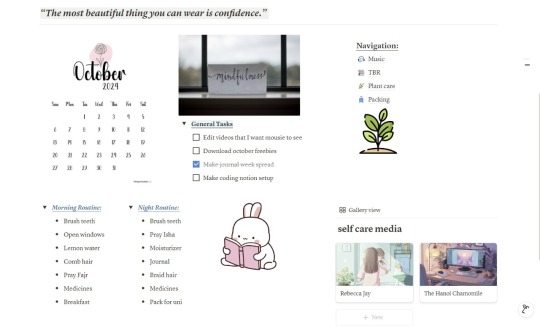
September 30, 2024 • Monday
End of the month! I'm feeling slightly better — today I was in the hospital for almost half a day because of a master health checkup and I was so tired when I got back. I fixed my notion a little, and trying to convince myself that missing classes is not that bad (even though it is pretty bad). Hoping the next month brings good days.

(edited)
Notion Setup Part 1 — Self care, Everyday life
I like having a picture of a pretty calendar at the beginning to like have an overview of hey look this is a month. (I know that's the shittier wording ever but its 3am cut me some slack)
A space for general tasks, things that I have to like washing my gloves or watering plants, or remind my mother of that one thing she told me to remind her about, etc
Under navigation, there's music (a to do list of artists and songs I wanna check out), TBR (books I wanna read), plant care (a description of the plants I own plus information for their care, like watering schedule, how to identify if my plants are dying etc), and packing (I travel to my native a lot so I have a detailed packing list with things I need to take, and how to seperate then in different bags etc so I don't have to think about it everytime).
My morning routine and night routine are not ordered, because as a disabled person my energy levels are unpredictable so sometimes I may not be able to do things in order, or I might skip some tasks. So I choose tasks from the routine list based on my energy levels for the day and complete only those.
A cute little section for some media I found that help me a lot (rebecca jay for self development vlogs on youtube, the hanoi chamomile for study with me videos, and a stress relief playlist on Spotify to calm my tics)
🎧 Lottery — GRAHAM

#dailyfoxposts#studyblr#studyspo#study#self care#notion#planning#productivity#self development#aesthetic#notion setup#notion setup post#digital planner
32 notes
·
View notes
Text
How to use time efficiently with many interests and work commitments.
⋅•⋅⊰⋅⋅•⋅∙∘☽༓☾∘∙•⋅⋅⋅•⋅⋅⊰⋅•⋅⋅•⋅∘☽༓☾∘∙•⋅⋅⊰⋅•
Being productive, making the most of the 24 hours of our day and getting a high ROI back is your goal, but your daily schedule and the endless appointments that you have make you too tired to get work done, let you feel like you have no free time, no time to even study, and you have to spend countless all nighters to get your work done questioning yourself why you chose so many activities/ extracurricular's etc. in the first place and all the free time you have your essentially doomscrolying it away making you more unmotivated.
This is a guide on how you can use your time efficiently and get a huge ROI back without feeling exhausted/tired and finding enough time to study thoroughly, getting your work done without loosing your passion for other things and doing your hobbies.
So the first thing you have to do is to go to a regular week and observe when you have free time, when you are binge-watching shows, doomscroll or when you are so unmotivated that you don't want to do your work, study, do your homework etc. and also what tasks do you have when you go to work/school when you come back, clubs meetings etc. So everything you do regularly in the week
Lastly in this week you have to identify a Prime time where you are the most productive so you can plan your tasks around it.
A list can look like this:
Observation
Monday: Going home from work/school at 16:30 - one hour free time - until I have to go to extracurriculars/ course etc.
Tuesday
Wednesday
….
Prime time: Weekdays 10-12pm Weekend 9-12am
₊˚ ‿︵‿︵‿︵୨୧ · · ♡ · · ୨୧‿︵‿︵‿︵ ˚₊˚ ‿︵‿︵‿︵୨୧ · · ♡ · · ୨୧ ₊˚
So, after you got the times where you are doing nothing/ wasting your time you have to start listing all the tasks and events you have, then categorize them based on importance and urgency.
For this you can use the Eisenhower-matrix
where you organize your work and projects into four categories: Important and Urgent, Important but Not Urgent, Urgent but Not Important, Not Urgent and Not Important.
The Eisenhower matrix, also known as the Urgent-Important matrix, is a time management strategy that helps you prioritize tasks based on urgency and importance.
The matrix has 4 quadrants or sections:
Important and Urgent: These tasks need immediate attention.
Important but not urgent: These are high priority items.
Urgent but not important: These are things that are time-sensitive but can often be delegated.
Not urgent and not important: These are activities that can either be delayed or removed from the list entirely.
example:
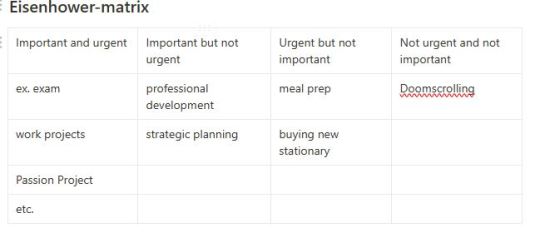
Planning your week in a strategic way
First you should Collect your observations in a 24 hours weekly planner like this and highlight the free time zones you have and also plan your regular sleeping time mine is from 10 to 5:30 am
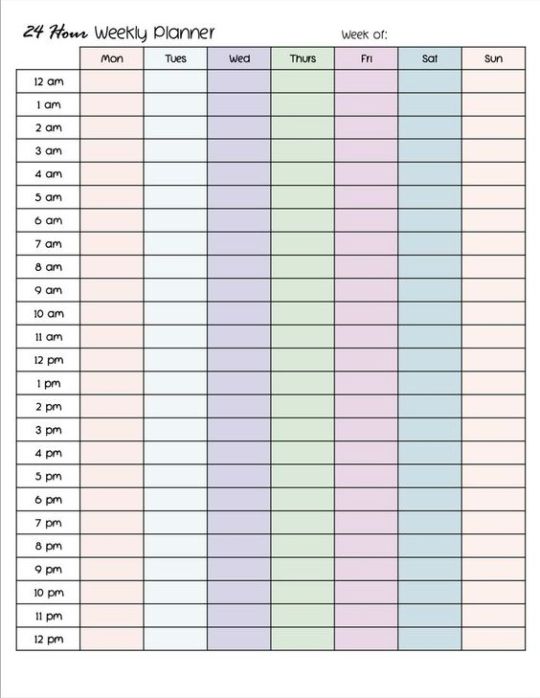
How to fill the free-spots:
Start by allocating time for high-priority tasks, then move on to lower priority ones, and finally use remaining time for recreation.
Place the high priority task in the (near the) prime time
If there are regular recurring tasks like homework hobbies etc. you should put it in a designated time slot
Try to avoid overworking yourself and prioritize your mental health.
Remember to take breaks in between tasks and give yourself a reward after completing something difficult or time consuming.
It's basically time blocking which is a method where you divide and schedule your day into focused intervals with no distractions
How to do the most in the weekend
After such a full week doing all your tasks you're obviously going to be tired and unmotivated to do anything. But the workload isn't going to get smaller but bigger in the next week, so you have to at least get something done. But do not force yourself to be 100% productive in the weekend because we all need some rest and constantly overworking yourself is unhealthy and also doesn't give you a good ROI in the long run.
Here are some methods that I've tried categorized in three levels: high; medium and low level depending on the mood you're in.
High level methods
The first method I suggest you to do is a method that is called Batch Tasking by Grouping
With this technique, you group similar tasks together and complete them in batches.
For example, you can have a morning batch of 'work-related tasks', an afternoon batch of 'personal tasks', and an evening batch of 'leisure tasks'.
This method can be useful for individuals who are motivated by completing multiple similar tasks at the same time, and it helps to avoid task switching and maintain a clear sense of purpose in your workflow.
The second method is the the "Marathon Mindset" technique
It's a method where you set a specific amount of time, say 3-4 hours, to focus intensely on completing your tasks. During this time, you can take short breaks (around 10 minutes) to prevent burnout, but the focus is on maintaining a steady work rate for the entire duration.
This technique can help you complete difficult tasks, and it's excellent for individuals who get into a 'flow' state when working on a project.
Medium level methods:
time boxing
This involves setting a timer for a specific amount of work, and once the timer goes off, you move onto the next task, no matter how much work was done. This helps create a sense of urgency and focus.
Time Boxing and Activity Swapping technique
Here, you set a short amount of time, say 15 minutes, for each task you want to complete. Once the timer goes off, you take a 5 minute break before moving onto the next activity.
But here's where it gets different: Each time you finish a task, you swap to a completely different activity than the last one. For example, after writing an email, you could do some calisthenics, then after that some cleaning, and so on.
This technique is great for individuals who struggle with task boredom
Low level methods
Focus on your "1 Thing"
it means working on the most important task each day, the "one thing" that'll move you closer to your goals. Once you've completed that 'One Thing' you can move onto the next.
This technique will help you to avoid multitasking and stay motivated, focusing your energies on completing the most crucial tasks first
Focus Sprint and Rest
Here, you work in intense 15-minute sprints, followed by a short 5 minute break. You repeat the routine 2-4 times before taking a longer break of around 15-30 minutes.
You can alternate between tasks or stay focused on one, depending on your preferences. This method is great for individuals who prefer shorter bursts of intense work, with short but regular breaks for a quick boost in energy.
Priority Power Hour
Using this technique, you dedicate a specific time of day, say 1 hour, to working on your most important and difficult tasks. Optimally this should be your power hour During this power hour, you commit to nothing else except completing these high-priority tasks.
The rest of your day can be spent doing less important tasks or working on other passions. The key benefit of this technique is that it allows you to stay focused and productive during your most efficient times of the day, while avoiding burnout.
Some last general tips
First, you should set achievable goals. This means breaking big tasks into small ones. This is very helpful if you have a big project that you have to do because the task load doesn't overwhelm you as much when you break aspects e.g. research as doing the whole project in a couple days and being very stressed.
Then you should limit distractions like your mobile etc. I would pack those things to another room so that they are not in front of your eye which makes you less likely to use them and get distracted. Also you should try to minimize multitasking because it diverts your attention on too many tasks and topics which makes your work imprecise and actually costs more time because you have to get into the thought process of topic 1 again.
Start with the end in mind. Define what you want to achieve during your sessions. Having clear goals helps you stay focused.
It's also important to schedule short breaks in the work session especially if you have many things to do to prevent burnout.
You should also have a monthly overview of important tasks separatly in a calendar
Regularly review your time management strategies and adjust them as needed. What's working? What needs improvement?
Lastly you should give yourself some rewards if you completed a difficult and important task to make you more motivate for more tasks
#wonyoungism#girlblogging#pink academia#becoming her#becoming that girl#girl blogger#pink pilates princess#productivity#time management#studyblr#productivitytips#productivityboost#productivity challenge#timemanagement#advice#that girl#dream girl essence#notion#time management strategies#dream girl#How to be NOT STRESSED out if you have a full plan#studyspo#literally me𓈒ㅤׂㅤ𐙚 ࣪ ⭒#Let's get productive Y'all#it girl energy#academic weapon#academic barbie#self improvement#self development#management
33 notes
·
View notes
Text


I HAVE BEEN WORKING ON THIS... FOR SO LONG... And there's definitely SO MUCH I can do better but ummm I'm proud of this!! And I will be doing much more like it. Inspired/referenced from Batman: Arkham Asylum, which I have been enjoying, except that Robin is TOO burly !!! get small idiot. Wayne Family Adventures flavored Asylum time plz.
Bonus sketches and the early version, which got critiqued by some friends whose harsh words made it WAY better, thank u <3

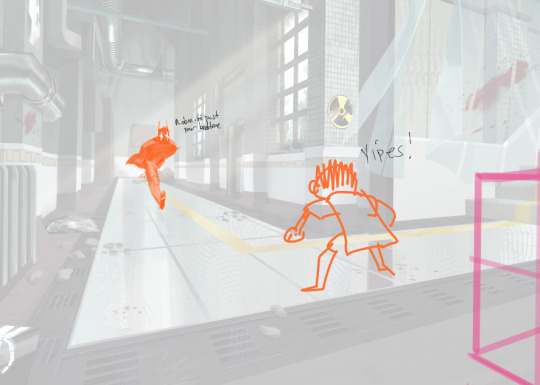
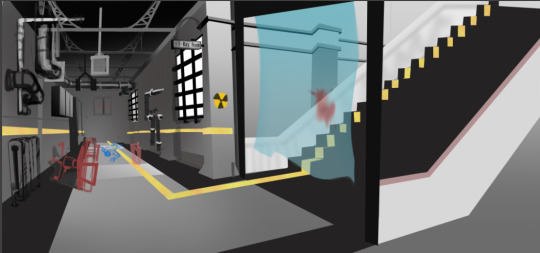
#my art#batman#arkham asylum#robin#tim drake#visual development#bg art#background art#background paint#background design#environment art#clip studio paint#digital art#artists on tumblr#color key#color keys#production art#concept design#I have a bunch more sketches for Aslyum alone and i have ideas for city . havent gotten to knight yet#AND ofc im also gonna do more non fan work... gotta bigggggggg portfolio project in planning rn#bitch im gonna draw so good and get hired#2023
84 notes
·
View notes
Text


Productivity Hours: (when our brain works best)
▫️ From 6-00 to 8-00 in the morning - at this time the brain processes information most efficiently, this is the best time for analysis, decision-making.
▫️ From 9-00 to 14-00 in the afternoon - at this time it is convenient to hold meetings, plan the day, do monotonous work that requires perseverance.
▫️ From 14:00 to 18:00 in the afternoon - the afternoon is ideal for physical activities.
▫️ From 18-00 to 21-00 in the evening - in the evening the brain actively generates new ideas, at this time it is useful to be creative.
#focusonyourself#leveling up journey#personal development#clean girl aesthetic#spoiled gf#light feminine#soft life#self love#self care#wellness girl#self development#that girl#becoming that girl#productivity#time management#daily routine#planning#psychology#brain works
146 notes
·
View notes
Text
Interview with Best Laid Plans the team behind Save the Villainess
I had the privilege of chatting with Tanya & Emily of Best Laid Plans @bestlaidplansproductions in an exclusive interview! We talked about their upcoming game, Save the Villainess & their experiences as a new dev in the indie VN space!
Check out the interview, shares and comments on the video always appreciated💖
youtube
#save the villainess#indie otome#indie game#interview#best laid plans productions#developer interview#behind the games#Youtube
16 notes
·
View notes
Text
The Ultimate Year-End Reset: Things to Complete Before 2025
As the final days of 2024 draw near, there’s something magical about the idea of starting fresh. The new year holds promise, but stepping into 2025 with clarity, purpose, and energy means taking a moment to pause, reflect, and reset. If you want to make the most of these last weeks, here’s your ultimate guide to wrapping up the year right. 1. Reflect on the Year Gone By Take a moment to sit…
#Achieve Your Goals#Build Better Habits#Celebrate Wins#Declutter Your Life#emotional growth#End-of-Year Reflections#Financial Planning#Finish Strong#Fresh Start 2025#Fresh Start Ideas#goal setting#Goal Setting 2025#healthy habits#Holiday Productivity#intentional living#life organization#Life Reset#mental clarity#Mindful Planning#Mindfulness#New Beginnings#New Year Goals#New Year Preparation#Organizing Your Life#personal development#personal growth#Plan Ahead#positive mindset#productivity tips#Self Improvement
3 notes
·
View notes
Text
These two mistakes are stealing your time... (They were stealing mine too!)

It can feel so disappointing to have a plan for your long-term goals written out and still feel like you are unable to achieve everything. I promise I've been there. There were two key mistakes I was making that were leaving me feeling overworked, and underproductive.
Mistake #1: Sleeping in.
I love being awake early... but I hate the act of actually waking up early. The relief that comes with knowing I'm up hours ahead of time, with plenty of wiggle room in my morning to get a head start on the day is amazing. All of a sudden, I realize my morning rush out the door doesn't need to be so stressful.
Sadly, that relief never makes the 5:00 AM alarm any easier.
The problem is that late nights lead to late mornings, and all too often I found myself rushing out the door unprepared for the day as the result of the previous night's pleasures and an extra hour of sleep. Don't get me wrong, it can feel great to sleep in on the weekend, but as my day has become less structured around a set "day job" schedule and more self-directed, I realized just how harmful the habit of sleeping in can be for an entrepreneurial lifestyle.
Many studies have led to the conclusion that our best ideas occur early in the morning and that we miss out on our most critical growth opportunities when we sleep in. I'm not saying that the early mornings are fun... I am saying that they are worth it.
Mistake #2: The cost of sacrificing high amounts of time into low-reward ventures.
As an entrepreneur, I understand the importance of casting one's net far and seeking new opportunities to learn and grow. However, sometimes your time is more valuable than what that opportunity itself may have to offer.
I recently accepted a minimum wage position (my first in years) on Saturdays, helping the owners of a small-town thrift shop set up their online sales channels. I didn't need the money, but I figured it was a great opportunity to explore online sales further as I had some experience with it already, and I loved the idea of helping another small business get off on the right track.
Unfortunately, I quickly learned that the two women who co-owned the business were not on the same terms about what they wanted long-term from the venture. Both had their own successful businesses on the side, and this little thrift shop was more of a hobby venture than one they truly wanted to see succeed.
Ultimately, it came to be that neither of them truly knew if they wanted an online sales channel at all! The six hours I spent there every Saturday was valuable time that I couldn't get back. While the idea of helping another business kick off was appealing upon a first impression, I realized that my time wasn't worth minimum wage in a place that clung to stagnation instead of capitalizing on new growth opportunities.
There will always be more opportunities than we can take — make sure the ones you do take are worth the time you will never get back.

What is the 12 week year? 7 ways to organize your life... 7 ways to reduce your screen time...
#get motivated#intentional living#intentionality#intentional screen time#content creator#digital well being#100 days of productivity#content creation#minimalism#motivation#self discipline#self control#self development#self sabotage#self improvement#confidence#princess productivity#productivity challenge#how to be productive#productivity#scheduling#planning#planner#management#budget#business#financial freedom#financial planning#budgeting#financial
5 notes
·
View notes
Text
Turning Ideas into Reality: The Journey from Vision to Achievement
Embark on the journey of turning ideas into reality with clarity and purpose. Set achievable goals, craft a roadmap, and conquer each step towards success.
Turning ideas into reality begins with a clear vision. Whether it’s starting a new business, writing a book, or developing a new skill, the process requires a well-defined roadmap and actionable steps. Here’s how you can transform your ideas into tangible outcomes by setting specific goals, creating a structured plan, and breaking down tasks into manageable steps. The Power of a Clear Vision A…
#achievement#action plan#Goal Setting#milestones#Motivation#perseverance#personal development#planning#Productivity#self-improvement#success#vision
2 notes
·
View notes
Text

Coaching Workbook, Business Coach Template, Career Planning Guide, Life Coaching Tracker, Editable Canva Template, Instant Download
Our Coaching Workbook is designed to assist you in planning your career. Whether you are just starting in your career or want to make a change, this workbook provides valuable tools and insights to help you achieve your goals.
This Business Coach Template is a comprehensive guide designed to give you career options. It provides a variety of tools and exercises to identify strengths, values, and interests, set achievable short and long-term goals, and provide a detailed road map for career success.
🌟 What's Inside 🌟
.: Welcome and Mission .: Client Data Sheet .: Summary of Career Objectives .: Self-Assessment .: Values and Interests Exploration .: Catalog of Skills .: Weaknesses and Areas for Enhancement .: Career Exploration Guide .: Action Plan Development .: Reflective Journaling Section
🌟 Why You'll Love It 🌟
.: Comprehensive Coverage .: Actionable Steps .: Reflective Exercises .: Professional Guidance
This Coaching Workbook provides professional guidance to help you make informed decisions and overcome challenges, ensuring that your career is aligned with your personal aspirations and professional goals.
Take control of your career with our Coaching Workbook and make informed choices that lead to professional fulfillment and success.
Order now and start planning your future today!
🌟 How It Works 🌟
.: Purchase the template. .: Download the PDF using the Canva link. .: Open the link and edit the template in Canva. .: Save and print your personalized planner or use it digitally.
#coaching#coaching and mentoring#digital products#business coaching#career planning#life coaching services#spiritual development#empowerment
3 notes
·
View notes
Text
Hey everyone! I submitted to the 72-Hour Murderboy Mayhem yesterday with a friend. Go check it out!
This game contains violence, gore mention, depictions of grief and loss of a loved one. Play at your own discretion
Years after the death of your beloved partner, Axel, you decided to purchase a robot duplicate of them in order to fill the gap they left on your life. All that is left is to train them to act just like them by going on various dates. However, not everything is as straight forward as you had hoped...
(3 endings, 2400 words, about 20 minutes of gameplay)
#game jam#vn#visual novel#game development#indie dev#murder sim#not the most polished since we ran into some production issues#but we got it out on time and that's the important part#dw we plan on polishing it up later
7 notes
·
View notes
Text
Steps to create a product-led development strategy
Product-led approach aims to identify market gaps and bridge it with efficient software. This blog unfolds the roadmap to build a product-based strategy
Know More : https://wseinfratech.com/infographics/how-to-create-a-productled-development-strategy

#social media communication strategy#customized digital marketing plan#customized search marketing plan#Product-led Development Strategy#Product Development Planning#product development process#software development company#custom product development
0 notes
Text
**Return to me post, aka fanfic post scroll away if you haven’t read it or do not care to read it**
This entire fic/au keeps rotting my brain especially after the recent thing i published of it even if I have to prioritize a huge fic but it’s all because of fucking EAGLE.
Just the concept of Ryoma and the Getter merging but in a way that isn’t self destructive. That Ryoma escapes his fate by making peace with the reality that the Getter and him are destined to be one but that doesn’t have to lead to a bad future. That it doesn’t have to lead to violence. And Eagle is an incomplete Getter. It’s not entirely Getter One, it’s only the plane that makes up it and other components of its counterparts. The Getter can never form again because Eagle is in Ryoma which causes a paradox-enemies cannot return because not all the pieces of the Getter is in place, even if Ryoma is there-and yet even if Eagle wasn’t originally what it’s supposed to be it’s free. It’s free from the cycle like Ryoma. It can be its own person even if it has to rely on Ryoma accepting it and being okay with sharing his body. It may not be the ideal image of man and machine living alongside each other but it’s a greater outcome than most universes with the Getter overtaking Humanity. One that truly define fate.
*flips table* FUCK
#meg text#getter robo#fanfiction#return to me#rtm#I made the sandwich but the sandwich is so fucking good#it’s a premium order#this narratively was aligning well with what new implied with ryoma but of course canon he could never see this#not that ryoma isn’t allowed to develop he is still interesting being a product of a cycle#but I focus on the angle of him escaping not just to cope but it’s just as intriguing#for him to become self aware to let go and find peace#and the getter alongside him does it as well#M A N#also fun fact Eagle was not fucking planned#a lot of rtm wasn’t planned accordingly but I’ll save it for another time if I feel like rambling more#But the tldr is this came up after chap 4 of wdky when Jaguar and Bear thought Ryoma was Eagle#and I went “wait what if it was LITERAL”#and let me fucking tell you it clears up a lot of earlier things I wrote for this au lol#(Yes in the chapter where ryoma was possessed I didn’t fucking know what that was about)#unintentional foreshadow bby
6 notes
·
View notes
Text
The Top 5 Budgeting Techniques Every Young Adult Should Know

In the roller coaster of life where new experiences and challenges can come at you fast, getting a grip on your finances is crucial. Let’s cut through the noise and explore five tried-and-true budgeting techniques that can put you in the driver’s seat of your financial journey.
The Foundation: Why Budgeting is Essential
Start Early, Thank Later
One of the secrets to a stress-free financial life is starting early. When you begin to budget in your younger years, you are not just counting pennies but also laying the foundation for a stable future. It is like planting a tree, the sooner you do it, the more shade you will enjoy down the road.
Read the Benefits
Proper budgeting does more than just prevent the dreaded end-of-the-month penny-pinching. It sets you up for success:
Save for Goals: Whether it is travel, higher education, or buying a home, a budget helps you put aside funds intentionally.
Avoid Unnecessary Debt: With a clear view of your income and expenses, you can make informed decisions, preventing you from spending more than you can afford to pay.
Achieve Financial Freedom: While it sounds dreamy, it is achievable. A well-maintained budget paves the way for peace of mind, giving you the freedom to live without constant money worries.
The 50/30/20 Rule
The 50/30/20 rule is a straightforward framework to help individuals allocate their income:
Necessities (50%): This segment is not just about survival but it is about maintaining a baseline quality of life. This should cover rent or mortgage, utilities, transportation, basic groceries, health insurance, and debt payments.
Wants (30%): This is not about reckless spending but acknowledging that leisure and entertainment are part of a balanced life. This can cover outings, special occasions, hobbies, dining out, and non-essential shopping.
Savings & Debt Repayment (20%): While part of this goes to savings, it is also about chipping away at any outstanding debt faster than just minimum payments.
Pros
Provide a simple structure ideal for those new to the budgeting process
Ensure you’re saving consistently every month.
Cons
One-size-fits-all percentages might not accommodate everyone’s unique situation.
Could be challenging in areas with a high cost of living.
Zero-Based Budgeting
Every dollar you earn should be put to use, whether that is paying for a service, buying goods, saving, or paying off debt. Each month, your budget should “zero out”:
Record Monthly Income: This includes your regular paycheck, any side hustles, rental income, and other sources.
Itemize Monthly Expenses: Start with fixed expenses (like rent) and then move to variable ones (like entertainment).
Match Income to Expenses: Deduct every expense from your income until you’ve allocated every dollar. If there is money left, put it toward savings or debt. If you are in the red, adjust your expenses.
Pros
Promotes intense awareness of your spending habits.
Can lead to a more frugal lifestyle as you critically evaluate every expenditure.
Cons
Requires frequent attention and adjustments, especially if you have fluctuating income or expenses.
Can be tedious for those not used to detailed financial tracking.
The Envelope System
Actual physical envelopes labeled for each of your expenses. After receiving your paycheck, you distribute cash into each envelope according to your budgeted amounts. When the envelope is empty, that is your cue: no more spending in that category for the month.
Tactile Advantage: The tangible act of handing over cash and seeing an envelope thin out offers a visceral connection to your spending, making you more conscious of your choices.
Digital Variations: With the world moving increasingly towards cashless transactions, use apps to mimic the envelope system with digital “envelopes” to help you allocate and track your spending in the same disciplined manner.
Pros
Provides clear boundaries for spending in each category.
Cultivates awareness and curbs impulsive spending.
Cons
Carrying cash can be inconvenient or even unsafe in some settings.
Might not cater to larger or online transactions.
The Reverse Budget Method
Instead of saving what is left after all expenses, this method flips the script. You decide on a savings goal and immediately set that amount aside when you receive your income. The remainder is then used for expenses.
Savings Commitment: By prioritizing savings, you ensure consistent progress toward financial goals, regardless of how the month’s spending unfolds.
For Variable Incomes: Since traditional budgeting can be hard when income isn’t consistent, reverse budgeting provides a way to ensure savings aren’t overlooked. By setting a percentage or fixed minimum amount to save, it instills discipline, even amidst financial unpredictability.
Pros
Prioritizes long-term financial health and goals.
Simplifies budgeting by focusing on one primary action.
Cons
Requires a strong commitment, as it can be tempting to dip into savings when other expenses arise.
Might not account for unexpected, high-cost necessities.
The Value-Based Budget
Unlike more rigid systems, the value-based budget doesn’t focus primarily on percentages, categories, or envelopes. Instead, it centers on your personal values, ensuring that the way you spend your money aligns with what matters most to you.
Self-Reflection: Begin with introspection. What truly brings joy, purpose, and meaning to your life? Is it travel? Perhaps education, or maybe supporting charitable causes? It is not about what society deems important, but what resonates with you.
Allocate Accordingly: Once you have identified your core values, align your spending to reflect them. This might mean allocating more to experiences over possessions if experiences are what you value most. Or it could mean setting aside a specific portion for charitable donations if giving back is a cornerstone of your values.
Pros
Creates a deep sense of fulfillment, as your spending is intrinsically tied to your passions and beliefs.
Provides flexibility, allowing for shifts in values and priorities over time.
Cons
Requires consistent introspection and honesty about what truly matters.
Lacks the structural rigidity of other methods, which can be a challenge for those who benefit from stricter frameworks.
Tips for Sticking to a Budget
Consistent Reviews
Consistent Reviews: Your financial journey is a living, breathing entity. To ensure you are navigating it efficiently, set aside time at least once a month for a budget review. This allows you to:
Identify areas where you consistently overspend.
Recognize positive patterns and reinforce them.
Adjust for any new income or unexpected expenses.
Set Realistic Expectations
Understand that budgeting is a skill developed over time. As you embark on this journey:
Celebrate small victories. Did you stick to your dining out budget this month? That is a win!
Don’t be disheartened by slip-ups. Instead, view them as learning opportunities. Analyze what went wrong and strategize for the future.
Embrace Flexibility
While discipline is a crucial aspect of budgeting, so is adaptability. Life throws curveballs, unexpected medical bills, car repairs, or other surprise expenses. When these arise:
Avoid panic. Instead, revisit your budget, making temporary adjustments to accommodate these unforeseen costs.
Consider having an emergency fund in place, which can act as a financial cushion for such scenarios.
Remember that every month might not look the same. Holidays, birthdays, or seasonal expenses can alter your spending. Anticipate these variations and adjust your budget accordingly.
Conclusion
Mastering your finances is an evolving journey, not a destination. Embrace the techniques that resonate, be patient with yourself, and remember: every step you take is one step closer to financial empowerment.
Follow our Instagram account for your daily dose of fun and inspiration!
Looking for a productivity tool that can help you achieve goals, set budget, and be more productive? Come learn about Illumtori!
#self improvement#100 days of productivity#goals#productivity#personal growth#personal development#finance#inspiration#motivation#personal finance#financial planning
6 notes
·
View notes
Text
Sunday, 3rd September
Day 21/100
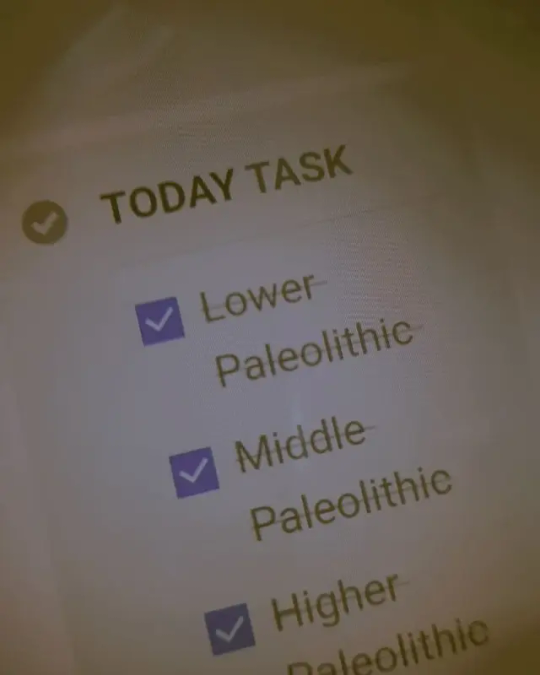

#study blog#blog post#that girl#trending#indian studyblr#study tips#upscaspirants#blogger#lifestyle blog#new blog#being productive#planning#productivity#100 days of productivity#self development#self discipline#discipline#desi tumblr#self improvement#studying#study#upscnotes#uniblr#uni life#upsc#upscexam#upscpreparation#upscmotivation#notion
5 notes
·
View notes
Text
What is the importance of time management in personal growth?
Time management is the practice of organizing and prioritizing your time to maximize productivity and achieve your goals. It’s a crucial skill for personal growth and development, as it allows you to make the most of your time and achieve more in less time.Here are a few reasons why time management is so important for personal development: Increased productivity: By managing your time…
View On WordPress
#goal setting#motivation#personal development#planning#prioritization#productivity#self improvement#stress management#time management#worklifebalance
2 notes
·
View notes